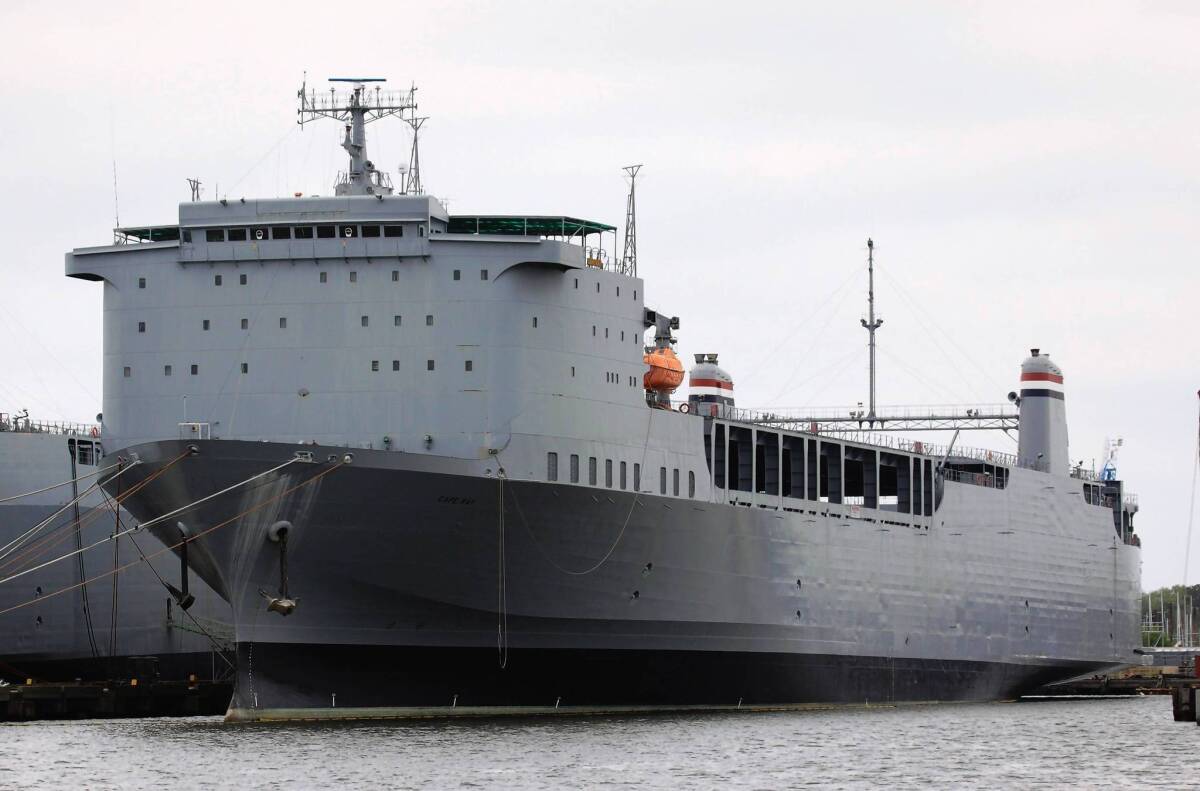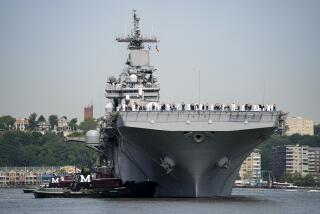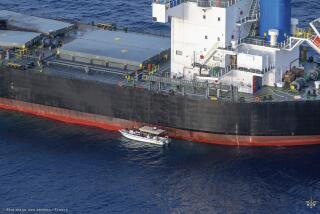U.S. outfitting ship to destroy Syria chemical weapons agents at sea

- Share via
WASHINGTON — The Pentagon is outfitting a 647-foot cargo ship with high-tech equipment in an effort to safely destroy hundreds of tons of lethal chemical weapons agents that were collected in Syria after a deadly gas attack this summer sparked an international outcry.
Two specially developed hydrolysis machines, which use water or bleach to neutralize the chemicals that produce nerve gases, have been installed aboard the Cape Ray at the U.S. naval base in Norfolk, Va., officials said Thursday.
The system should be able to eliminate Syria’s VX and sarin stockpiles and chemical components in 45 to 90 days, the officials said. No chemicals will be dumped at sea.
With Syria engulfed in civil war, moving the deadly material to the U.S. naval ship over the next month may be the biggest challenge.
Plans call for trucking the arsenal from a series of collection sites to the Syrian port of Latakia, where it will be loaded into 150 Teflon-lined shipping containers. Pentagon planners fear that even a heavily guarded convoy could be attacked en route to Latakia by insurgents battling President Bashar Assad’s forces.
“Obviously, it’s a challenging environment,” said a U.S. official, who briefed reporters on condition of anonymity to discuss military operations.
After poison gas rockets hit rebel-held suburbs of east Damascus on Aug. 21, killing more than 1,000 people, according to U.S. officials, Assad agreed to surrender his stockpiles to international chemical weapons inspectors and thus avoid a threatened retaliatory attack led by the U.S. military.
Over the last few months, the teams have dismantled or destroyed Syria’s chemical weapons production facilities and warheads, but they now must get rid of bulk liquid chemicals that are mixed to form the nerve gases.
Destroying the material at sea was chosen as a last resort when no country agreed to do it on land. Norway has offered to ferry the sealed containers from Latakia to an as-yet-unnamed port outside Syria, where they will be transferred to the Cape Ray, the officials said.
The U.S. officials refused to say if the Cape Ray would stay in the Mediterranean Sea while the destruction process was underway or would sail elsewhere. They also refused to discuss what security would be provided.
No U.S. government personnel will be in Syria to assist with the operation and no U.S. military forces will be involved in protecting the Syrian trucks as they transport the chemical agents to Latakia.
Under a timetable established by the Organization for the Prohibition of Chemical Weapons, which is working with the United Nations to carry out the disarmament, the most dangerous material must be removed from Syria by the end of this year. Under a U.N. Security Council resolution, the entire stockpile must be destroyed by mid-2014.
The Pentagon has offered use of the ship to the Hague-based organization, which has not formally accepted the offer but is expected to shortly.
The modified ship is expected to undergo a sea trial this month and be ready to sail early next year.
It also is being outfitted with an analysis lab and a protective system that includes a large tent to prevent hazardous material from escaping the hold if an accident occurs. Workers now being trained will wear protective suits.
The Pentagon has used hydrolysis machines to help destroy parts of its own once-vast chemical weapons stockpile, although never before on a ship. The machines eliminate 99.9 % of the chemical agents, creating a liquid byproduct that is considered hazardous waste but has a low level of toxicity, according to one of the U.S. officials.
The liquid will be stored aboard the Cape Ray, which will be manned by about 60 Defense Department civilians and contractors, until arrangements can be made to destroy it at a commercial waste treatment facility.
Most of Syria’s agents are in liquid bulk form that need to be mixed to produce a usable weapon, officials said, making it easier to neutralize them instead of destroying them through incineration, a process that would have to occur on land.
The Cape Ray is owned by the U.S. Maritime Administration, a federal agency that maintains a reserve fleet of ships that can be leased to help the Pentagon transport vehicles and other equipment during hostilities or in other emergencies.
More to Read
Sign up for Essential California
The most important California stories and recommendations in your inbox every morning.
You may occasionally receive promotional content from the Los Angeles Times.














